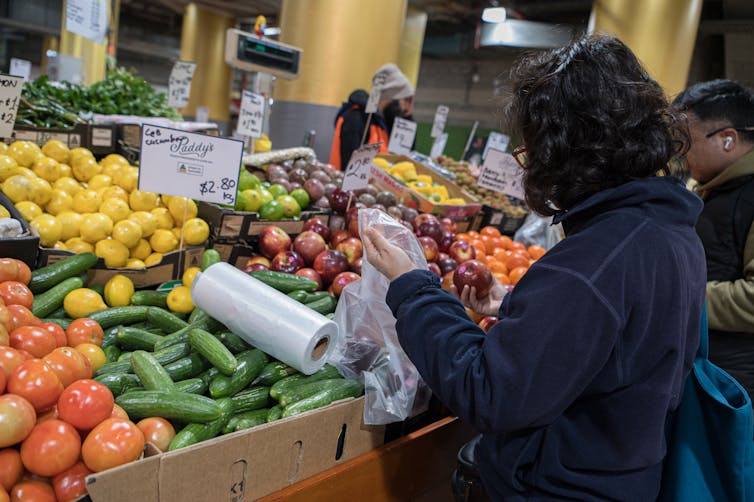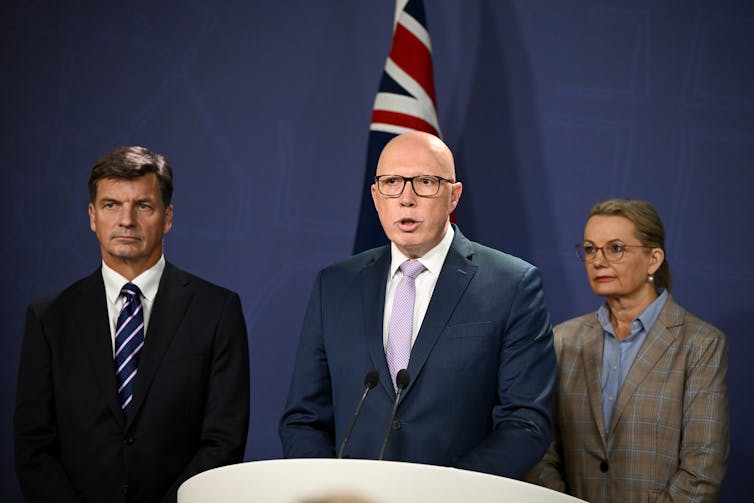With a federal election due by May 2025, few doubt it will be fought over the high cost of living, with emphasis on energy policy and the punishing effects of electricity prices. But the underlying condition of the economy will determine the salience of these arguments with voters.
In other words, the “climatic” or structural conditions of the economy – which are largely beyond the control of politicians – will help either to validate or to neutralise the charges of the various parties, be they government, opposition, Greens or independents.
This matters given the centrality of climate and energy policy. A campaign fought on those issues might be expected to benefit the Greens and the Teal independents – but the Coalition believes it can turn these issues into hip-pocket concerns.

The language of election campaigns
Consider this scenario. It is February 2025 and what has felt to ordinary folk like a recession has lingered for two years. Now, however, things are looking up and attention is turning to an imminent federal election campaign.
Who would be winning in the opinion polls? In all likelihood, this would turn on how long inflation had persisted and on whether its abatement had brought material interest rate relief in time for the election season-proper.
Even if we assume the inflation dragon has been tamed – brought below 3%. How swiftly and decisively would the Reserve Bank move to ease the mortgage and rent pressure on households and businesses? Cautious to a fault, the central bank would want to be sure that prices stabilisation was robust.
Let’s say rates did come down. Even improving conditions carry with them fresh memories of hardship – and perhaps, exaggerated fears of an economic relapse. As Frank Bongiorno has previously observed, John Howard’s scything rhetoric from opposition, ahead of his 1996 election win, is a case in point:
Howard’s quip from opposition in 1995 – that the recovering economy was “five minutes of economic sunlight” – was effective politics. But it was not supported by the new government’s own records, which referred to a “generally favourable outlook”.
The lesson here is that political messaging resonates when it feels right to voters – even if it is not technically correct.

Conditions are ripe for the Greens and Teals
Leaving the vagaries of prediction and the power of negative rhetoric to one side, what we can clearly observe at the halfway point of 2024 is that both sides – indeed all sides – claim they will be delighted if the election contest in 2025 centres on climate change.
Of course, they can’t all be right. Inevitably, the politico-climatic conditions will suit some political critiques more than others.
For Adam Bandt’s Greens party, which quadrupled its holdings in the House of Representatives at the 2022 election, climate policy and environmental protection is core business.
The Greens have seized the initiative on soaring rents – a pivotal issue for younger voters. And the party has sharply criticised the Albanese Labor government’s approval of new fossil fuel projects, claiming it leaves Labor’s renewable energy policy fatally compromised – akin to stepping on the emissions brake and the accelerator at the same time. Some, perhaps many, voters will agree.
And what of the Teal independents? In 2022, they received funding support from Simon Holmes a Court’s funding vehicle, Climate 200. Clamour for a rapid transition to renewable energy was central to the Teals’ identity, and therefore, to their attraction of votes. Their astonishing success in seizing solid inner-urban Liberal seats was specifically enabled by the Morrison Coalition’s climate policy shortcomings, among its multiple failings.
Labor also grasped the climate challenge in both hands, although its promised 43% cut to emissions by 2030 was deliberately less ambitious than the policy it proposed in 2019. Now there are doubts even this commitment will be met, raising prospects for the Greens and Teals.
Peter Dutton’s high-risk wager
And then there’s Peter Dutton’s Coalition. Dutton has boldly sought to claim a relationship between Labor’s existing green energy transition and high electricity prices – a relationship which is largely fictitious.
“I’m very happy for the election to be a referendum on energy,” Dutton said, while committing his party to a radical nuclear power policy that is both costly and potentially decades away.
Dutton contends his capital-intensive nuclear option would get Australia to net-zero emissions by 2050. But will voters buy his new green muscularity? And what about his own colleagues? Some Coalition MPs are privately eyeing their leader’s high-risk nuclear adventure with trepidation. One told me it is an “all or nothing bet, with the odds favouring nothing”.
Former prime minister Malcolm Turnbull is less circumspect. Twice cut down by the right for his efforts to “green” the Liberal Party, Turnbull has slammed as delusional the proposal to bring seven state-owned and operated nuclear reactors online in 20 to 30 years. As he wrote for Guardian Australia:
The first episode of the climate wars was a tragedy, the second is an expensive and dangerous farce.

A fascinating contest
Even if the 2025 election race had not acquired this nuclear energy flashpoint, it would already be a fascinating contest. That’s because Dutton, like his predecessor Tony Abbott, has sought to frame the Labor-Green-Teals push to reduce emissions as the cause of high household electricity prices.
However effective this may be, Dutton’s determination to drag the Liberal-National parties further to the right has nonetheless raised hopes the Teals will not merely retain their seats in 2025, but potentially double them. To that end, Climate 200 intends to financially assist pro-climate community candidates in three Victorian seats (Casey, Monash, Wannon), two New South Wales seats (Cowper, Bradfield) and four Queensland seats (McPherson, Moncrief, Fisher, Fairfax).
This matters in the overall election outcome. Intentionally or otherwise, the Teals have become a “Swiss Guard” for Albanese, making it difficult for Dutton’s Coalition to reach the 76 seats it needs to form majority government.
Difficult, but not impossible. As always, the economic outlook, both real and perceived, will be pivotal.

